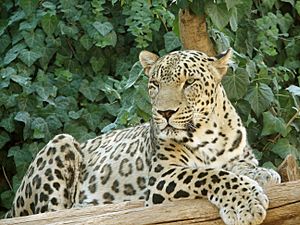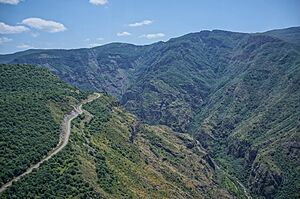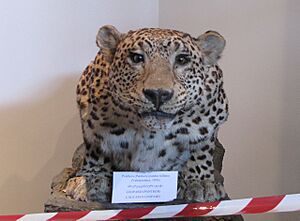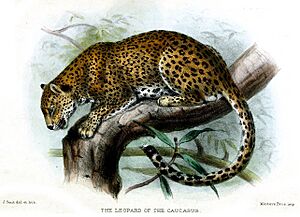Anatolian leopard facts for kids
Quick facts for kids Panthera pardus tulliana |
|
|---|---|
 |
|
| Conservation status | |
| Scientific classification |
|
| Kingdom: | Animalia |
| Phylum: | Chordata |
| Class: | Mammalia |
| Order: | Carnivora |
| Suborder: | Feliformia |
| Family: | Felidae |
| Subfamily: | Pantherinae |
| Genus: | Panthera |
| Species: | |
| Subspecies: |
P. p. tulliana
|
| Trinomial name | |
| Panthera pardus tulliana (Valenciennes, 1856)
|
|
 |
|
| Distribution of P. p. tulliana, 2016 | |
| Synonyms | |
|
|
The Panthera pardus tulliana, also known as the Anatolian leopard, Persian leopard, or Caucasian leopard, is a type of leopard. It was first described in 1856 from a specimen found in western Anatolia (modern-day Turkey). These leopards live in the Iranian Plateau and nearby areas, stretching from eastern Anatolia and the Caucasus to the Hindu Kush mountains. They prefer to live in high-up meadows, forests, and rocky valleys, often at elevations between 600 and 3,800 meters (about 2,000 to 12,500 feet). They mostly hunt hoofed animals that live in these areas.
Today, there are fewer than 1,100 adult leopards left in this region. Their homes are shrinking because of changes in land use. They are also in danger from illegal hunting, a lack of their natural prey, and being killed by people when they hunt farm animals. This leopard is protected by international laws like CITES Appendix I.
Contents
- What is the Anatolian Leopard?
- What Does the Anatolian Leopard Look Like?
- Where Do Anatolian Leopards Live?
- What Do Anatolian Leopards Eat and How Do They Live?
- What Dangers Do Anatolian Leopards Face?
- How Are Anatolian Leopards Being Protected?
- Anatolian Leopards in History and Culture
- See Also
- Images for kids
What is the Anatolian Leopard?
The Anatolian leopard is a specific kind of leopard found in West Asia. Scientists first gave it the name Felis tulliana in 1856. This name came from a leopard skin and skull found near a city called Smyrna in western Anatolia.
Over the years, other scientists described leopards from different parts of the Middle East, giving them different scientific names. For example, in 1899, a leopard from the Caucasus was called Felis pardus tulliana. Later, in 1914, another leopard from the North Caucasus was named Felis ciscaucasica. In 1927, leopards from Persia were named Panthera pardus saxicolor.
For a long time, people thought the Anatolian leopard was a separate group found only in western Turkey. However, when scientists compared leopard skulls from different areas, they found they were very similar. Thanks to DNA analysis in 1996, it became clear that many of these different names actually referred to the same type of leopard.
In 2017, scientists decided that all these leopards in West Asia belong to one subspecies, and the oldest name, P. p. tulliana, is now used for all of them. This means the Anatolian, Persian, and Caucasian leopards are all the same subspecies.
How is this Leopard Related to Others?
Studies of leopard DNA show that the P. p. tulliana belongs to a group that separated from African leopards and Arabian leopards a long time ago. Leopards in Iran are part of a single group, showing they are closely related.
What Does the Anatolian Leopard Look Like?
The Anatolian leopard has fur that is grayish and slightly reddish. It has large, ring-shaped spots called rosettes on its sides and back. Smaller rosettes are found on its shoulders and upper legs, while its head and neck have solid spots. The color of its fur can vary, with some leopards being pale and others darker, even within Iran.
On average, these leopards are about 158 centimeters (about 5 feet 2 inches) long, not including their tail. Their tail can be quite long, around 94 centimeters (about 3 feet 1 inch). An adult leopard can weigh up to 60 kilograms (about 132 pounds). Some studies in Iran found that the average body length, including the tail, can be around 259 centimeters (about 8 feet 6 inches). A young male leopard from northern Iran was recorded weighing 64 kilograms (about 141 pounds).
Where Do Anatolian Leopards Live?
These leopards live in various places across West Asia. In the Greater Caucasus mountains, they prefer high-up meadows, mixed forests, and rugged valleys, from 600 to 3,800 meters (about 2,000 to 12,500 feet) high. In the Lesser Caucasus and Iran, they live on rocky slopes, mountain steppes, and thin juniper forests.
| Country | Year | Estimate |
|---|---|---|
| Iran | 2022 | 550–850 |
| Pakistan | 2022 | 130–178 |
| Turkmenistan | 2022 | 60–80 |
| Azerbaijan | 2022 | 6–17 |
| Iraq | 2022 | 9 |
| Armenia | 2022 | 3–9 |
| Russia | 2022 | 6 |
| Nagorno-Karabakh | 2022 | 2 |
| Georgia | 2022 | 1 |
| Kazakhstan | 2022 | 0–5 |
| Turkey | 2021 | less than 5 |
| Afghanistan | 2022 | unknown |
| Total | 2022 | 750–1,044 |
In northern Turkey, leopards have been seen in the Pontic Mountains. A camera trap even caught a picture of one in Trabzon Province in 2013. They seem to like areas with sparse forests, rocky places, and areas near rivers. In southeastern Turkey, they have been seen in Diyarbakır Province and Bitlis Province. In 2018 and 2019, they were photographed on Mount Cudi, which might be a path they use to move between Turkey and Iraq.
In the Caucasus region, leopards have been seen in Georgia, often in dense forests. Scientists hope they will become more common there if they are well protected. In Armenia, camera traps have recorded leopards in the Zangezur Mountains, which are important breeding areas. In Azerbaijan, leopards have been photographed in Hirkan National Park, which connects to mountains in Iran. This shows that leopards move between these countries.
Iran is considered a very important place for these leopards. They are more common in the northern part of the country. The Caspian Hyrcanian mixed forests along the Alborz Mountains are one of their most important homes. Many leopards have been found in protected areas in Iran, and families with cubs have been seen, showing that these areas are good for breeding.
Leopards have also been recorded moving from Iran into Turkmenistan, showing that populations in these two countries are connected. In Pakistan, they live in Himalayan forests and mountains. In Kazakhstan, leopards have been recorded in the Jambyl Region and Mangystau Region, with one photographed in Ustyurt Nature Reserve in 2018.
Where Did They Used to Live?
Historically, the Anatolian leopard probably lived across the entire Caucasus region, except for the flat steppe areas. The northern mountains formed the edge of their old home. In Armenia, leopards and people have lived together for a very long time. In the mid-20th century, leopards were quite common in Armenia's mountains.
Ancient stone traps for leopards still exist in the Taurus Mountains in southern Turkey. The last leopard in Syria was reportedly killed in 1963. In western Turkey, the leopard population declined sharply between the 1940s and 1970s. This was due to trees being cut down, natural areas being turned into farms, roads being built, and leopards being killed for hunting farm animals. By the mid-1970s, they were thought to be gone from western Turkey.
In southern Russia, the leopard population became very small and isolated by the 1950s. In Georgia, leopards were thought to be gone after 1954 due to hunting. The breakup of the Soviet Union in 1992 led to economic problems and weaker protection for wildlife. This caused leopard habitats to break apart, and leopards were hunted, along with their prey.
In Afghanistan, leopards are thought to live in the central highlands and the Wakhan corridor, but none have been photographed recently. Long conflicts in the country have badly affected both leopards and their prey.
What Do Anatolian Leopards Eat and How Do They Live?
The diet of the Anatolian leopard changes depending on where it lives. In southern Armenia and Iran, they mostly hunt wild goats, mouflon (a type of wild sheep), wild boars, roe deer, goitered gazelles, Indian crested porcupines, and European hares. Sometimes, they will attack farm animals and herding dogs. In Iran, leopards are often found where there are many wild goats and wild sheep. They have even been seen attacking an onager (a wild donkey). In Turkey, they also hunt chamois (a goat-antelope).
Adult male leopards often share their living areas with two or three adult females. The time when they mate is usually from mid-January to mid-February. In Sarigol National Park, Iran, female leopards were seen with one or two cubs in late April to May. A female with two cubs was also photographed in the Alborz Mountains.
What Dangers Do Anatolian Leopards Face?
Since 2016, these leopards have been listed as Endangered on the IUCN Red List. This means their wild population is estimated to be less than 1,000 mature adults.
The main dangers to P. p. tulliana include:
- Illegal hunting: People still hunt them illegally.
- Lack of prey: There aren't enough wild animals for them to hunt because people hunt their prey too much.
- Human activity: Things like military training in border areas disturb them.
- Habitat loss: Their homes are disappearing due to trees being cut down, fires, farms expanding, too much grazing by livestock, and new buildings and roads.
In the 1980s, anti-personnel mines were placed along the northern part of the Iran-Iraq border. While these mines kept poachers away, at least two leopards are known to have stepped on them and died. In northern Iraq, cutting down trees is a major threat, made worse by economic problems.
Between 2004 and 2007, 85 leopard skins were found for sale in markets in Kabul, Afghanistan. In Armenia, even though there was enough food for leopards, their numbers were very low. This was due to illegal hunting, disturbance from livestock farming, collecting plants, cutting down trees, and human-caused wildfires.
Only a few small and isolated groups of leopards remain in the Caucasus. Their suitable homes are limited, often in remote border areas. These small groups depend on leopards moving in from larger populations, mainly from Iran.
In Turkey, leopards have been killed illegally in traps and by poison. Several leopards have been killed since 1974 in different provinces. Even though Turkey is trying to plant more trees, it doesn't have a plan to connect fragmented forests. This could make leopard populations even more separated.
In Iran, the main threats are changes to their habitat, illegal hunting, and too many farm animals in leopard areas. Leopards are unlikely to survive outside of protected areas. Dry weather in many leopard habitats has also affected their main prey, like wild goats and wild sheep.
Between 2007 and 2011, 71 leopards were killed in Iran. About 70% were hunted or poisoned illegally, and 18% died in road accidents. From 2000 to 2015, 147 leopards were killed in Iran. More than 60% died from illegal hunting, poison, or being shot. About 26% died in road accidents. More male leopards were killed than females. Leopards are sometimes killed by herders if they attack farm animals. Leopards have also injured people, mostly when they felt threatened by herders.
How Are Anatolian Leopards Being Protected?
The Panthera pardus (leopard species) is listed in CITES Appendix I, which means international trade in these animals is banned. It is also protected by the Berne Convention, which aims to conserve European wildlife.
Many countries have laws to protect these leopards:
- In Azerbaijan, they have been protected since 1969.
- In Armenia and the Soviet Union, they were protected in 1972.
- The Caucasus leopard population is listed as critically endangered in Russia's Red Data Book.
- In Iran, they have been protected by law since 1999.
- In 2001, hunting leopards was banned in Nakhchivan Autonomous Republic.
- In Afghanistan, it was added to the Protected Species List in 2009.
- In Kazakhstan, hunting leopards became a criminal offense in 2021.
- In Turkey, the leopard is part of a plan to protect endangered species.
In 2001, a five-year project started in the Caucasus to help leopards. This project included surveys, planning new protected areas, training border guards, and educating children in schools. An anti-poaching unit was also set up in Armenia. In 2005, Armenia approved a plan to protect leopards, seeing them as an "umbrella species" – protecting them helps protect many other species too.
In Iran, a leopard conservation plan was approved in 2016. Organizations like Future4Leopards Foundation work to protect them. Conservationists hope to encourage people to protect and connect suitable leopard habitats, including international Wildlife corridors. These corridors help leopards move safely between different protected areas.
Scientists believe there is enough suitable habitat in the Caucasus for over 1,000 leopards. However, for the population to survive and grow, illegal hunting must be reduced, and their prey animals need to recover.
Bringing Leopards Back to the Wild
In 2009, a special center was opened in Russia's Sochi National Park to breed and reintroduce leopards. Leopards have been brought from zoos to this center. Their cubs have been released into the wild in 2016 and 2018, including in the Caucasus Biosphere Reserve and Alaniya National Park.
Leopards in Zoos
As of 2021, there are over 100 Persian leopards in zoos around the world. The European Endangered Species Programme has a special breeding program to keep a healthy group of these leopards in zoos, acting as a backup population.
Anatolian Leopards in History and Culture
Images of the Anatolian leopard have been found in the ancient city of Thyatira in Anatolia, dating back to the Neolithic period (Stone Age) until the 6th century BC. Leopards are shown on statues, pottery, ivory carvings, and coins linked to the Lydian culture. Many of these items were found in places used for worship.
The Roman statesman Cicero, who was a governor around 50 BC, asked for leopards to be sent from Anatolia for gladiators to fight. This is why the leopard's scientific name, tulliana, comes from his middle name, Tullius. Leopard skin patterns were also used on Anatolian carpets and traditional robes called kaftans.
The Natural History Museum of the Aegean on Samos Island in Greece has a stuffed leopard. It is said to have been killed on the island in 1862 and is labeled Kaplani, which means leopard in Greek. It's possible a leopard swam across the 1.7-kilometer (about 1 mile) channel from the Turkish coast to reach the island. Another leopard reached Samos in 1836 and was trapped.
The story of the leopard on Samos Island inspired the Greek author Alki Zei to write a children's novel called Wildcat Under Glass.
See Also
- Leopard subspecies
- Chinese leopard
- Zanzibar leopard
- Leopard attack
- Wildlife of Turkey
Images for kids








